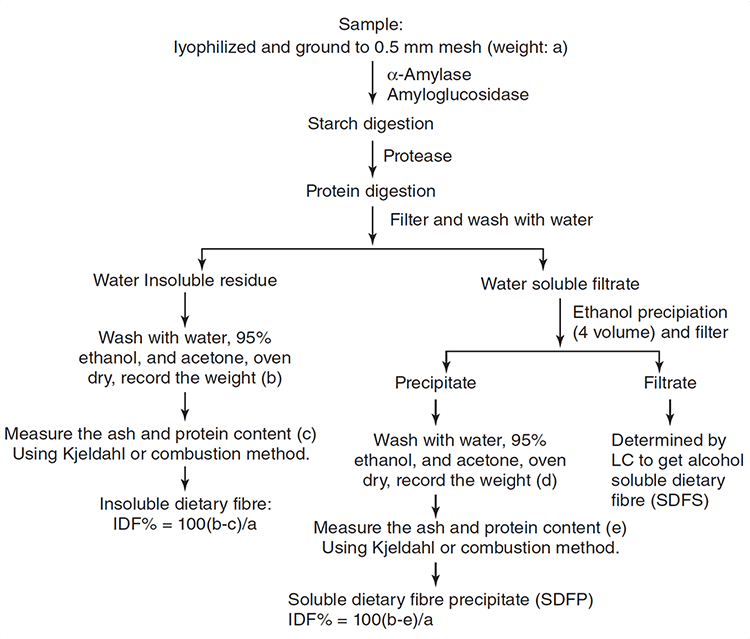Dietary fiber is the edible parts of plants or analogous carbohydrates that cannot be digested or absorbed by human bodies. Dietary fiber is an essential food ingredient with a nutritional value of 2 kcal/g, which is much lower than the nutritional value of digestible carbohydrates (4 kcal/g). Dietary fibers have been shown to promote numerous beneficial physiological properties such as decreasing the intestinal transit time, lowering cholesterol and blood glucose levels, trapping harmful substances (e.g., mutagenic and carcinogenic agents), stimulating the proliferation of the intestinal flora, alleviating constipation, and many others. Because of these obvious benefits for human health, food products that contain dietary fibers (either naturally occurring or as food additives) have become increasingly popular worldwide. Following this trend, there is an arisen demand for developing advanced methods to precisely measure the contents of dietary fibers in food.
Lifeasible is a leader in food nutritional analysis with a state-of-the-art platform for dietary fiber analysis. We provide various advanced official analytical methods related to dietary fiber analysis adopted by AOAC and AACC, including:
- Nonenzymatic-gravimetric method. This method (such as AOAC 993.21) is applied for the determination of >10% total dietary fiber (TDF) in food products.
- Enzymatic-gravimetric method. This method (such as AOAC 991.43/AACC 32-07.01) allows measurement of total, soluble, and insoluble dietary fiber in a variety of food products, such as grain and cereal products, processed foods, fruits, and vegetables.
- Enzymatic-spectrophotometric method. The content of total fructan (inulin and fructooligosaccharides) in foods can be determined by this method (such as AACC 32-32.01), and inulin can be measured by AOAC 993.03.
- Enzymatic method. The enzymatic method (such as AACC 32-22.01) is designed for quantification of β-glucan in oat fractions and unsweetened oat cereals.
- Anion-exchange chromatographic method. These methods can be used for determination of the contents of trans galactooligosaccharides (e.g., AOAC 2001.02/ AACC 32-33.01), polydextrose (e.g., AOAC 2000.11/AACC 32-28.01), fructan (e.g., AOAC 997.08/AACC 32-31.01), etc..
- Combination of different methods. The contents of insoluble, soluble, and total dietary fibers can be quantified independently by an enzymatic-gravimetric method and liquid chromatography (e.g., AOAC 2009.01/AACC 32-45.01 and AOAC 2011.25/AACC 32-50.01 (Figure 1)).
 Figure 1. Flow chart of soluble, insoluble and total dietary fiber determination by an enzymatic/gravimetric/LC method of AOAC 2011.25/AACC 32-50.01 (Guo et al., 2014).
Figure 1. Flow chart of soluble, insoluble and total dietary fiber determination by an enzymatic/gravimetric/LC method of AOAC 2011.25/AACC 32-50.01 (Guo et al., 2014).
With cutting-edge equipment, advanced technologies, and excellent experts, lifeasible provides reliable dietary fiber analysis services to help you precisely label of your product to comply with health claims. Our dietary fiber analysis service is featured with:
- Highly qualified team and comprehensive testing methods
- Accurate testing results with a short turnaround time
- Extensive portfolio with multiple kinds of dietary fibers
- Design and optimize of testing methods on your request
- Research support to assist you with dietary fiber product development
- Close co-operation with certification bodies, food industry, and technical associations
Welcome to contact us for further information, questions, and inquiries.
Reference:
- Guo Q.B.; et al. Chapter 16 Classical methods for food carbohydrate analysis Food Oligosaccharides: Production, Analysis and Bioactivity, First Edition. Edited by Dr. F. Javier Moreno and Dr. Mar´ıa Luz Sanz. JohnWiley & Sons, Ltd. 2014, 284-299.
For research or industrial raw materials, not for personal medical use!
 Figure 1. Flow chart of soluble, insoluble and total dietary fiber determination by an enzymatic/gravimetric/LC method of AOAC 2011.25/AACC 32-50.01 (Guo et al., 2014).
Figure 1. Flow chart of soluble, insoluble and total dietary fiber determination by an enzymatic/gravimetric/LC method of AOAC 2011.25/AACC 32-50.01 (Guo et al., 2014).